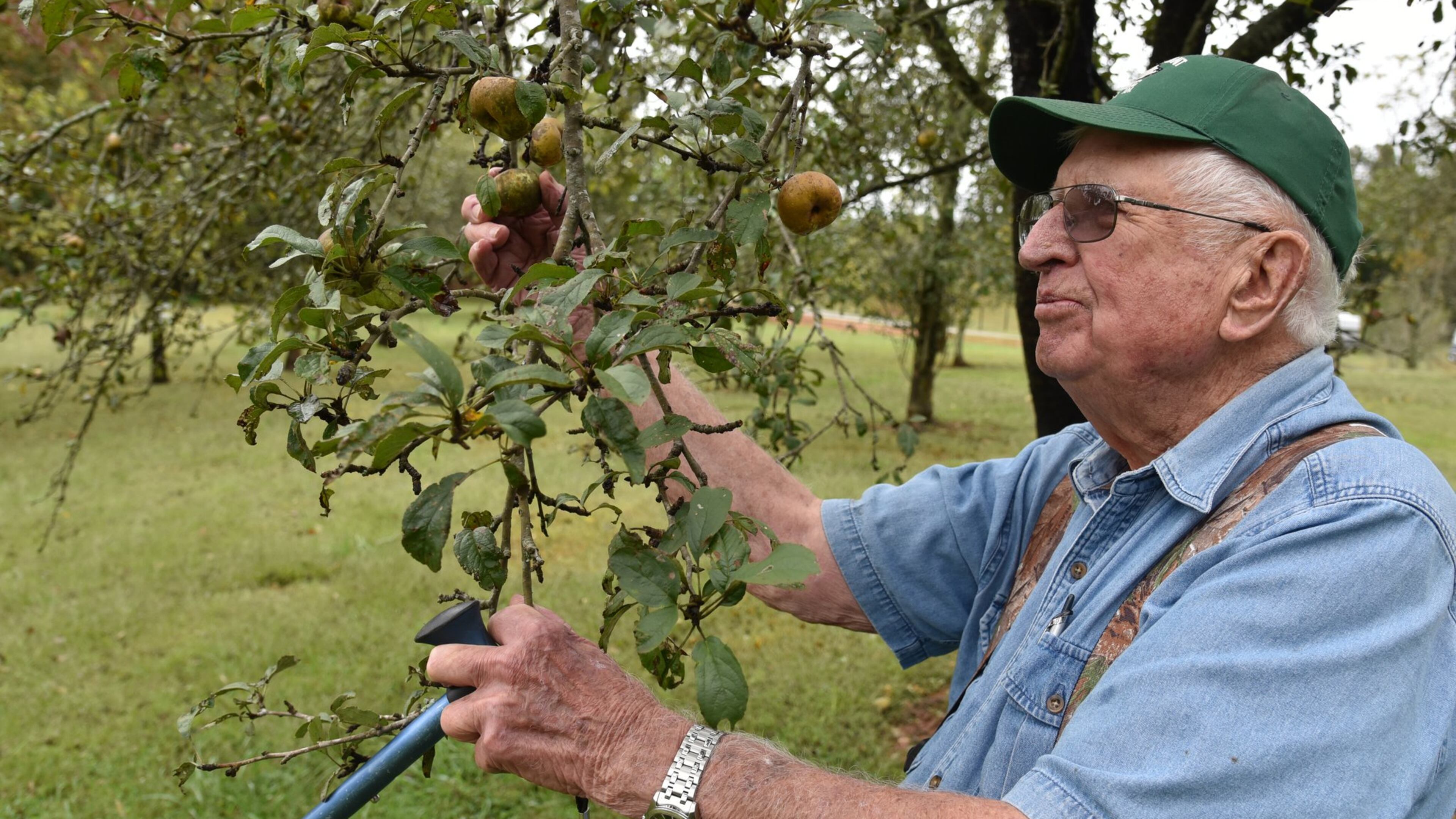North Georgia nurseryman a legend among apple growers

“That’s a Mollie’s Delicious,” says Jim Lawson, 89, hiking in the field behind his nursery on Yellow Creek Road.
“It’s a good-tasting apple, but susceptible to fire-blight. I never did like to fool with it much.”
Lawson, a nurseryman for 70 years or so, and a legend among pomologists up and down the East Coast, is about to give a lesson in bench grafting.
He knows how it's done. For decades Lawson's Nursery, in Ball Ground, shipped 20,000 apple trees across the country and beyond every year. His catalog was huge, with 250 varieties to choose from, including such vintage strains as King David, Arkansas Black, Black-Sheep Nose and Rambo. And Lawson bench-grafted every single one, snipping "scion wood" — a new shoot from an old tree — from a variety that he planned to propagate, and wedding it with a slip of rootstock ordered by air freight from Oregon.
He's the "Paul Bunyan of bench grafting," according to New York orchardist Eliza Greenman, who is among Lawson's many admirers. Earlier this year Greenman made a special pilgrimage to North Georgia to interview Lawson for her blog. "I feel blessed beyond words," she wrote, "to run across people like this in my life."
Choosing a bit of new growth from the Mollie’s Delicious tree and taking his square-ended pocketknife out of his overalls, Lawson demonstrates that bench grafting is a bit like cutting a dovetail joint in the ends of two pencil-thin sticks. When they are fitted together, the seam is almost invisible. Though he is white-haired now, and steadies himself with a walking stick, his knife is sharp and accurate.

At one time, Lawson could “whip-and-tongue” 1,000 of these in a day. These days Lawson is semi-retired. But apple tourism in North Georgia, just now shifting into high gear, keeps barreling long.
The Georgia Apple Festival in Ellijay takes placethis weekend and next (Oct. 11-12, 17-18) and car-loads of Georgians will be clogging the twisty roads in Gilmer, Pickens, Dawson and other counties to the north, lining up at pick-your-own farms and riding hay wagons with visions of apple cider doughnuts dancing in their heads.
Historically, Lawson’s customers have come from farther afield — New York, Virginia, California, Texas, even Central America and West Africa. He sold some of his trees to commercial growers, but more of his customers were small farmers, hobbyists who’d already had their fill of McIntosh and Fuji and would rather bite into an heirloom Limbertwig, Lord’s Seedling or a Cox Orange Pippin.
In his heyday, he tramped through abandoned orchards and homesteads, collecting scion wood from dying trees (with the permission of landowners) and saving varieties such as the Disharoon, extinct since 1855. He also raised new trees whose heritage was a mystery. He named the reborn trees after farmers (like the Rev. Morgan) or locales (like the Frosty Mountain) associated with the cuttings.
This has made him a historian of apples and apple trees, and has made his tree yard a kind of repository of apple genetics unique in the world.
“He saved a lot of stuff that possibly would be gone,” said David Lockwood, apple and bunch grape specialist with University of Georgia Cooperative Extension Service.
Lawson’s catalog was a thing of beauty. Often listing up to 200 different varieties, the black-and-white illustrations were augmented with indelible descriptions. This is how the Smoke House Apple was described: “yellow or greenish with rather dull red, sometimes deepening to solid bright red indistinctly mattled striped and spished with carmine.”
Celestine Sibley, the late Atlanta Journal-Constitution columnist who lived in a 150-year-old cabin called Sweet Apple, once sought Lawson’s advice, asking if he knew of a way to find out which apple her homestead was named for. Whatever that tree was, she wanted to plant one.
Lawson decided to hedge his bets and created a tree with a dozen or so different varieties of “sweet” apples grafted onto it, each branch producing a different flavor — Summer Banana, Carolina Red June, Striped June, Summer Sweet, and so on.
The Gilmer County native didn’t start out growing apple trees. He worked a variety of jobs as a younger man, from the marble mine to the sawmill. In the meantime he bought his grandfather Si Lawson’s 18-acre farm, and kept expanding the orchard, doing all the grafting himself, to ensure it was done right.
Eventually he went with apples full time. “It’s just a hobby that got out of hand, ” he explained to the AJC back in 1986. “I sure didn’t have no degree in horticulture.”
He used his common sense, and his extensive collection of apple textbooks — some of them more than 100 years old — to identify what he found. A Texas preacher named Rev. Morgan sent him some scion wood from a tree that seemed to do well in Houston, contrary to the usual results when apple trees are planted in the humid Texas environment. Morgan thought he had planted seed from a Granny Smith, but this variety was different, and produced a sweet fruit that thrives even in Costa Rica.
“I’ve grafted several thousand of those over the years,” said Lawson, of the Rev. Morgan variety.
Ah, but apple trees grow older, and people do, too. On Dec. 14 Lawson will turn 90. Bernice, his wife of 57 years and his partner in the business, died in 2001.
Lawson still drives and lives on his own, though his three grown children, who live close by, frequently check in. He only has a few dozen trees left, and just does a little custom grafting these days. He does no mailing, letting his customers drive in from Virginia and Kentucky to pick up their seedlings.
On this day Lawson chats with friends who come by, including neighbor Hollis Garmon, a fellow “geezer” with whom he enjoys sitting and solving the problems of the universe.
And as for his longevity: Is it due to an apple a day? “Ha!” Lawson laughs. “More like a snort of apple brandy a day.”


